Editor’s Note: Last updated on March 13, 2022
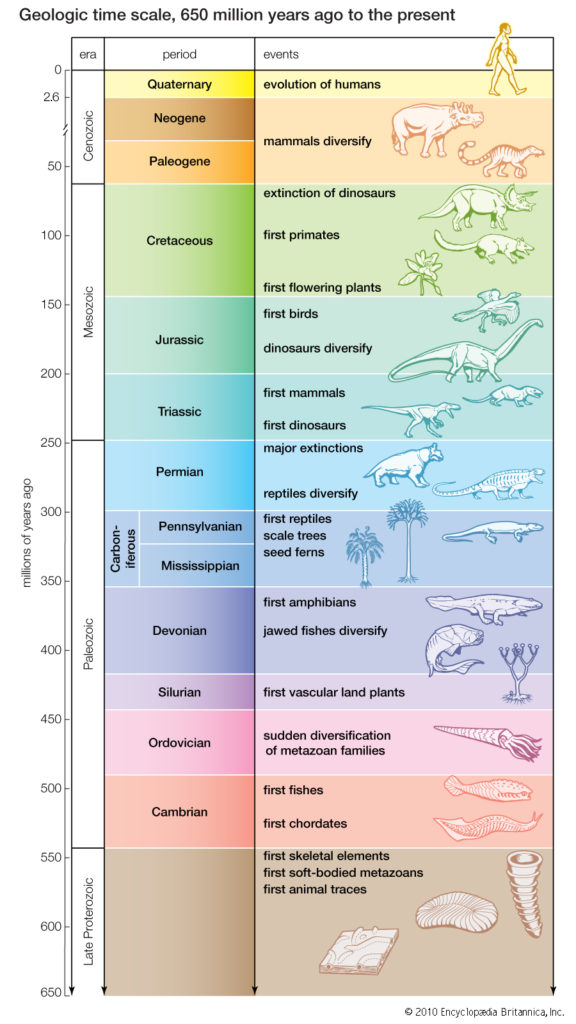
Young-earth creationists believe Noah’s Flood to have been global in its extent. It forever reshaped our planet’s surface. However, determining where the Flood layers start (the pre-Flood/Flood boundary) and end (the Flood/post-Flood boundary) is perhaps the most widely discussed and hotly debated field of young-earth geology research.
The purpose of this article is to summarize the main views and apply them to a real-world example. It is our hope that it will equip you to investigate the claims of each one for yourself. This will allow you to arrive at your own conclusion. Due to the nature of this topic, this article is subject to changes/updates in the future and may only represent the current literature on the topic.
Where Do We Start?
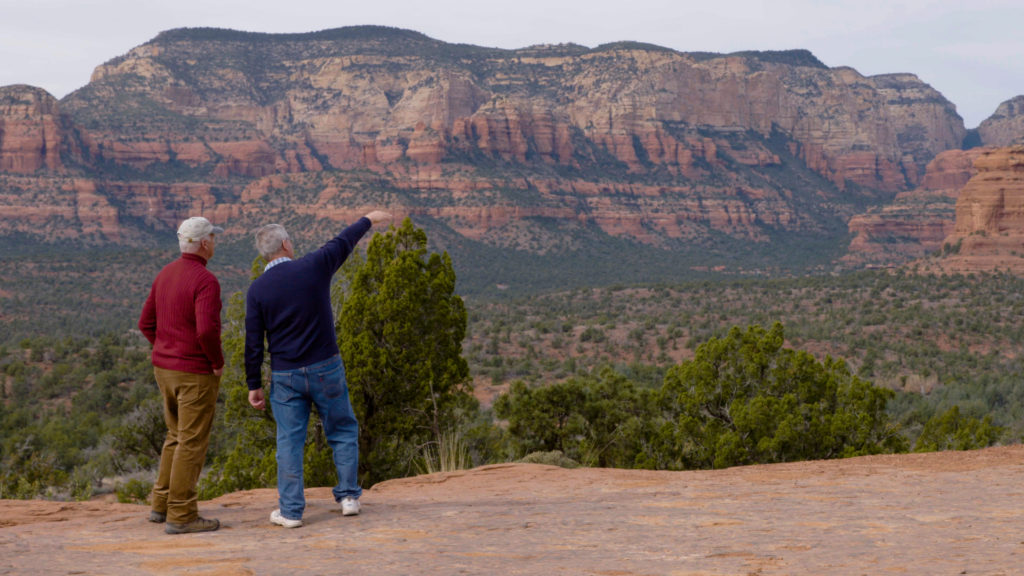
The earth’s continental crust consists of many layers. Like the pages of a book, each layer tells a story of our planet’s history. Its “historians” ―called geologists―carefully study these rock layers and attempt to determine what story they are trying to tell us through the passage of time.
But this book is incomplete and hard to read. Some important pages have been ripped out; some rock layers have eroded away. Others have folded, faulted and/or slid over other pages of the book (as really happens to some rock layers!). Still others give us trouble with their interpretation, much like deciphering the story detailed in some lost language. The geologic record is hard to decipher!
As should be clear by the end of this article, creationists hold a diverse array of opinions regarding how much of the geologic record was a direct result of the Flood. We should point out that we needn’t assume the entire geologic record formed during a single event during the Flood. Different time periods, or “epochs”, punctuate Biblical history. Each is unique in its own way.
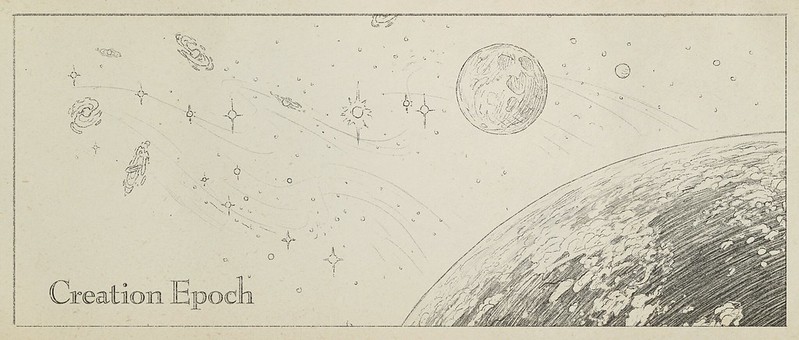
The universe and everything in it was supernaturally created by God in the span of six regular days just a few thousand years ago. Everything in Creation was “very good.” Animals and humans lived in harmony with their Creator and each other, eating only plants.
Click here to learn more about the Creation Epoch.
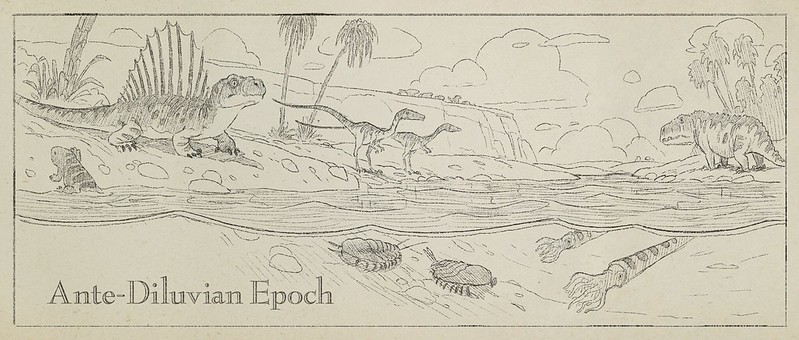
In response to Adam and Eve’s rebellion against the Creator of the universe, He cursed all of His creation. Death, disease, bloodshed, and suffering were introduced at this time. In the generations that followed, violence increased among humans and animals. Some creatures became vicious predators.
Click here to learn more about the Curse and the Antediluvian Epoch.
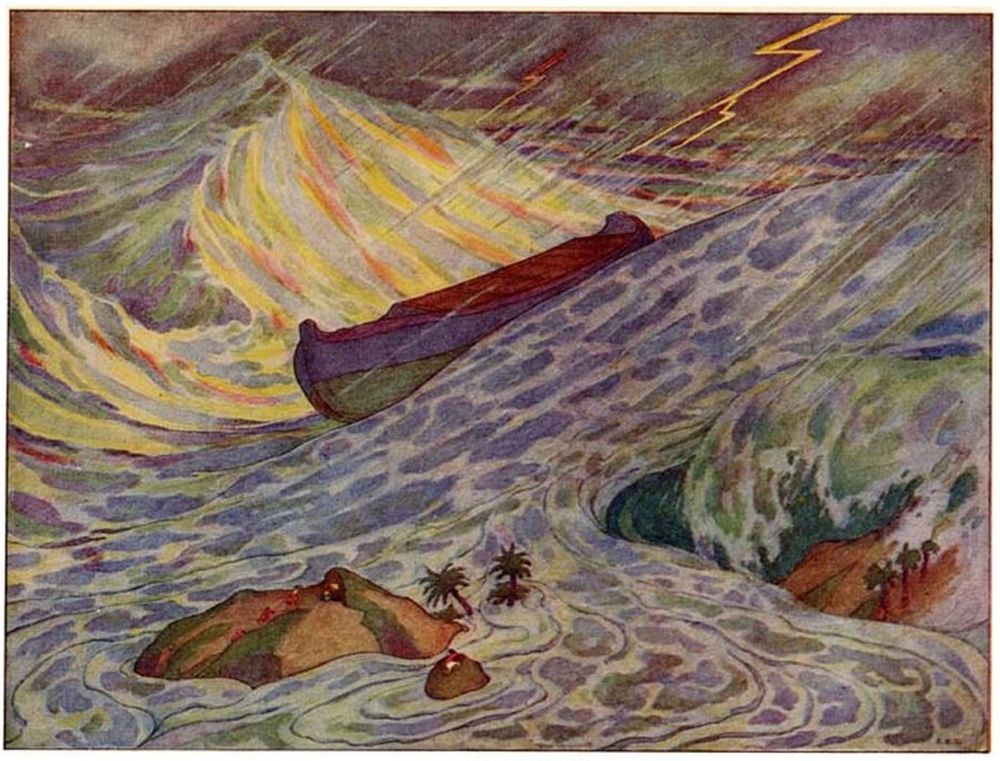
Noah’s Flood
When violence and wickedness of the Antediluvian world reached a breaking point, God subjected it to judgment by sending a worldwide Flood. The floodwaters destroyed all humans, air-breathing land animals, and even the surface of the earth itself. Only the righteous man Noah, his family, and a handful of representatives were spared aboard an Ark.
Click here to learn more about Noah’s Flood.
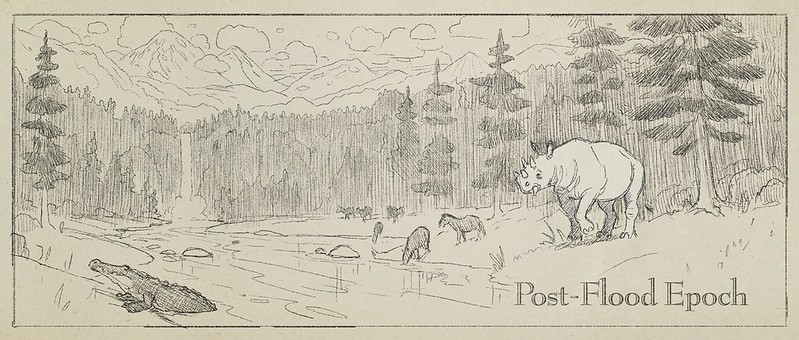
The Flood of Noah’s day destroyed the earth, leaving it quaking for centuries in its wake. It is during the Arphaxadian epoch that the world recovered from the greatest catastrophe in its history. Plants and animals recolonized the earth as it was rocked by natural disasters that successively decreased in power and size as the Flood became an increasingly distant memory. It came to a close with an Ice Age that held the earth in an icy grip for the next several hundred years.
Click here to learn more about the Arphaxadian Epoch.
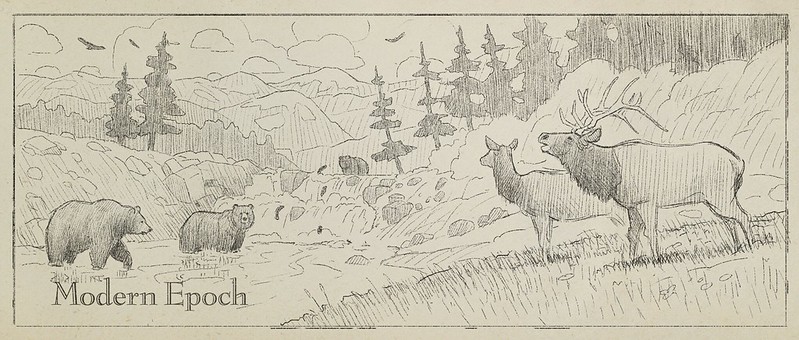
The Modern epoch is signified by the appearance of human fossils, artifacts, structures and cultures all over the world. Geologically speaking, the earth has become somewhat stable by this time, punctuated by occasional large-scale natural disasters.
We wouldn’t expect geologic features from the Modern epoch to match those left behind by the Flood. Nor would we expect the Arphaxadian epoch to have left behind identical evidence to that formed during the Antediluvian epoch. This is something we should actively keep in mind on our search for the Flood in the earth’s geologic record.
How Do We Find the Flood?
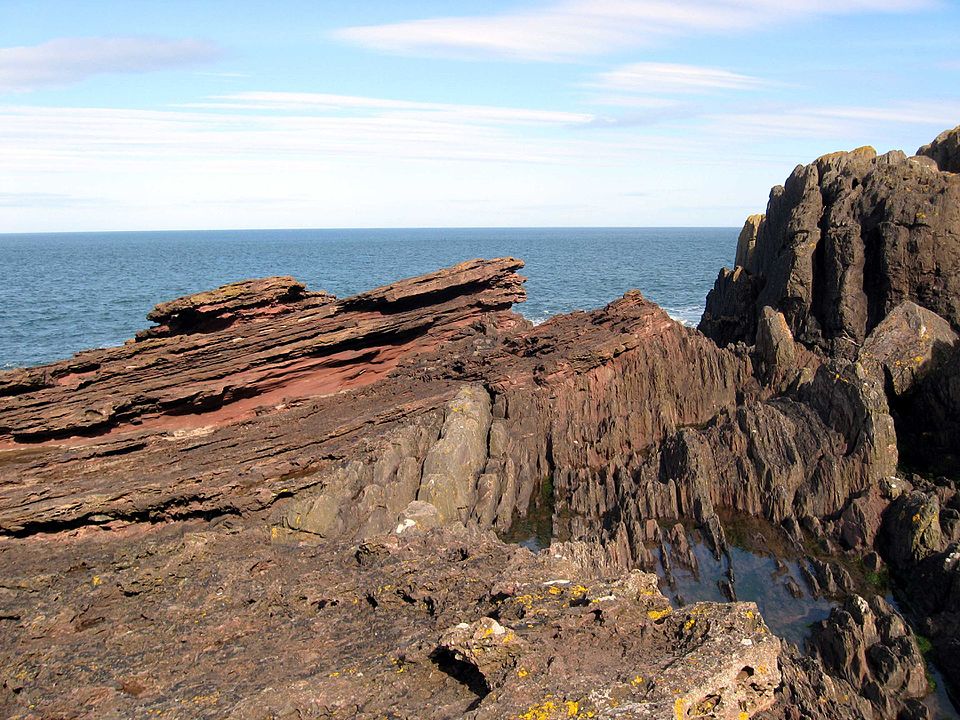
Firstly, we should remember that the debate over the Flood’s location in the geologic record is an “in-house” debate. All of the models discussed below reject naturalistic evolutionary theory and any notion that the earth is billions of years old. Secondly, and most important, all of these models recognize that young-earth geologists have an important data point that their old-earth colleagues just don’t. We have an eyewitness account from Someone who knows everything, has always existed, and saw the events of history unfold: the Creator of the universe, God Himself.
God has provided us with the CliffsNotes rendition of early earth history in the first chapters of Genesis with helpful tidbits scattered throughout the rest of Scripture. From it we can glean an overarching sequence of events that would have contributed to the geologic record.
Step 1: Understand Flood Chronology
As a global cataclysm, the Flood certainly would have left geologic clues behind in its wake. More than that, the Flood and its aftermath involved a unique and complex series of events. Each one was distinct from the others. This should allow us to correlate specific units of the geologic record with specific phases of the Flood itself. Determining what these biblical eras are and what makes them unique should be our first step. This will require more than a mere cursory reading of the biblical text.
One such effort is the Cataclysm Chronology Research Group (CCRG). Their goal is to piece together a consistent, cohesive chronology of the events that occurred during the year-long Flood. Before we can understand how biblical history and geological history correlate, there are several chronology-related questions we must answer. Were all pre-Flood land animals and man “blotted out” in 150 days or just 40 days? What were the “windows of heaven” and the “fountains of the great deep”? When exactly did mountaintops begin to appear as the Flood reached its end? The answers to questions like these have major implications for how we might interpret the geologic record.
Once complete, a cohesive Flood chronology will provide young-earth geologists with the necessary framework for the construction of a biblically-consistent Flood model. Check out the articles below for some of the CCRG’s recent breakthroughs.
- Anderson, L., Jr. (2014, April 1). “A Deeper Understanding of the Flood—Details Matter.” Answers Magazine.
- Boyd, Steve W. “The Last Week before the Flood: Noah on Vacation or Working Harder than Ever?” Answers Research Journal, vol. 9, 17 Aug. 2016, pp. 197–208.
- Boyd, S. W. (2020). “It’s for the Birds: Avian Fine-Tuning of Flood Chronology.” Answers Research Journal, 13, 135-152.
Step 2: Correlate Biblical History with Geological History
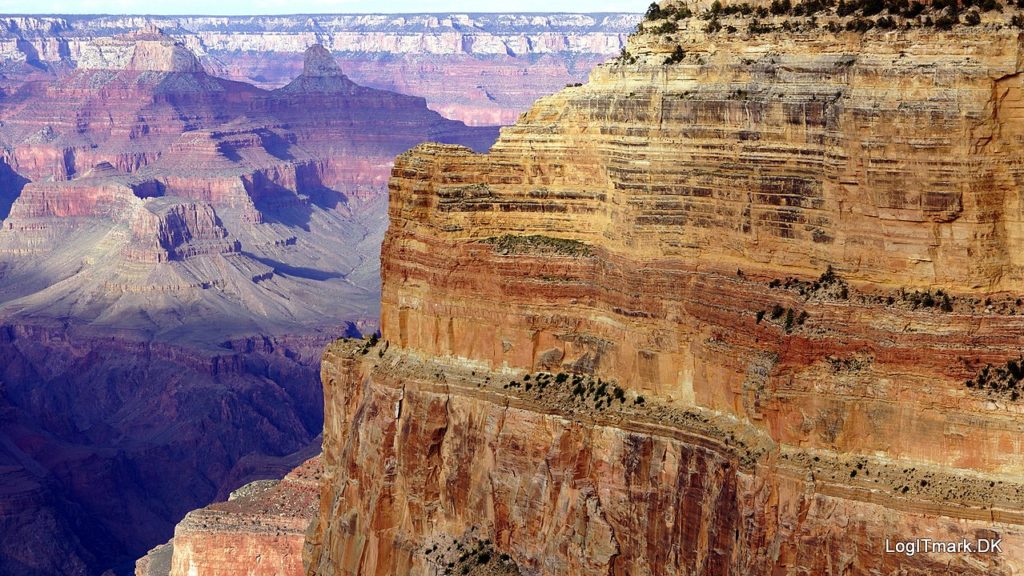
Once we have assembled a sound chronology of the Flood, the next step will be to correlate the events recorded in the Bible to specific signatures in the geologic record. Can we identify at what point in geologic history sea levels were at an all time high, à la Genesis 7:20? What can we expect of the fossil record formed during the inundation phase versus the recession phase? Where are the “fountains of the great deep” referenced in Genesis 7:11 located today?
Also necessary is the correlation of the geologic record with pre-Flood and post-Flood history. Can we identify clues in Precambrian rocks that point us to the existence of a worldwide ocean (Genesis 1:2-3) that preceded the uplift of dry land (Genesis 1:9)? How soon after the Flood did the Ice Age occur? Did it coincide with early patriarchs like Abraham and Job?
Many creationists have tried to correlate certain rock layers to the Flood merely on the basis that they appear to have formed during a catastrophe. This is improper. There have been many other natural disasters and other catastrophes in earth’s history aside from the Flood. In fact, they still happen today, albeit on a much smaller scale! Consider the eruption of Mount St. Helens in 1980 and its aftermath, or the horrific tsunami that devastated the Japanese coastline in 2004. While these natural disasters pale in comparison to the ones evidendenced in the geologic record, they can provide us with clues and helpful visuals to give us an idea as to what they may have been like while they were happening.
Always Verify
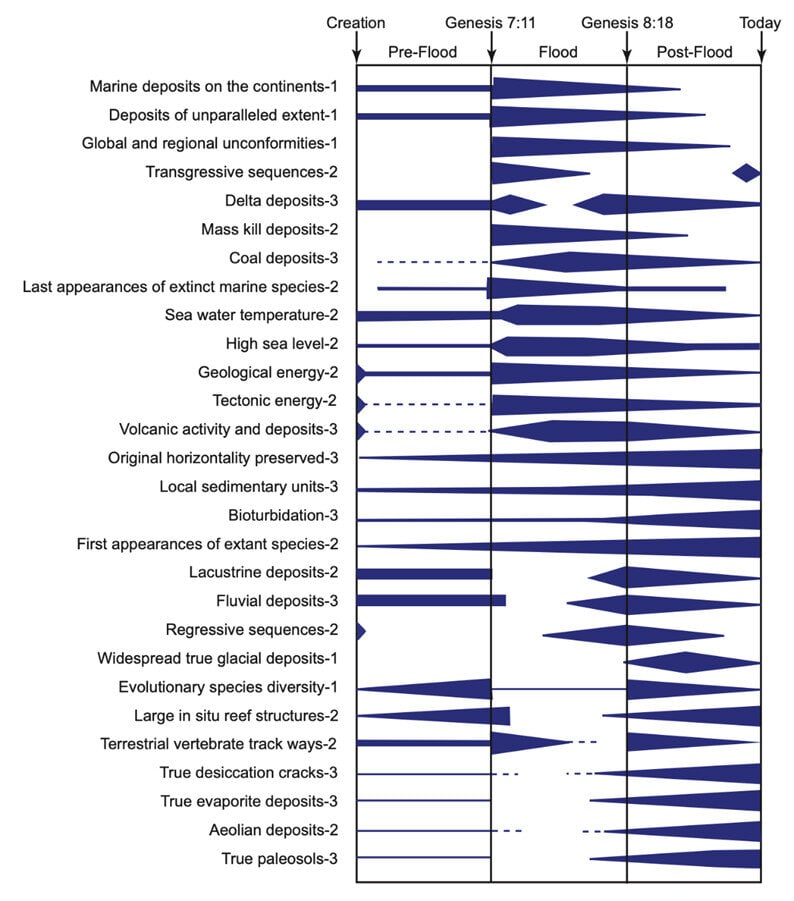
A better approach is to use a suite of criteria. We can use a series of characteristics to determine whether a rock deposit was formed before the Flood, during the Flood, or after the Flood. For example, we might expect a global Flood to have left behind thick layers of water-deposited sediment that are of unparalleled extent, perhaps regional or even global in scale. Whereas, we might expect to find deposits of more localized extent or in basins if we are dealing with post-Flood geology.
In this type of investigation, it is imperative that we reevaluate the interpretations of rock formations and fossil deposits produced by secular geologists. This has already proven useful in many instances by revealing data that was overlooked by the old-earth advocates. For example, researchers often cite the Coconino Sandstone of the Grand Canyon as an aeolian (wind-blown sand) deposit. If correct, this would indicate that the Coconino Sandstone may have formed after the Flood, as some creationists have suggested. However, research by geologists Leonard Brand and John Whitmore suggests that it actually formed in a watery environment. This is something we would not have known if we had not investigated the data for ourselves and come to our own conclusion.
Verifying even well-established “facts” about how the geologic record formed (even if it is consistent with how we as young-earth creationists think it happened) helps to strengthen our understanding of the data and how it best correlates to the biblical record.
Step 3: Determine Which Flood Model is the Most Parsimonious
When we say that a scientific theory or model is parsimonious, we mean that it has the greatest ability to explain the data we currently have at hand. So we must figure out which Flood model is the best fit based on what we know about the biblical record and the geologic record. This involves identifying what criteria and potential flaws characterize certain aspects of the various Flood models and comparing them against observed geological patterns in the rocks.
For example, if all air-breathing land animals and humans perished within the first 40 days of the Flood, models that suggest otherwise would be unacceptable. On the other hand, such models are acceptable if the time the Flood narrative allots is closer to 150 days.
Flood Boundaries
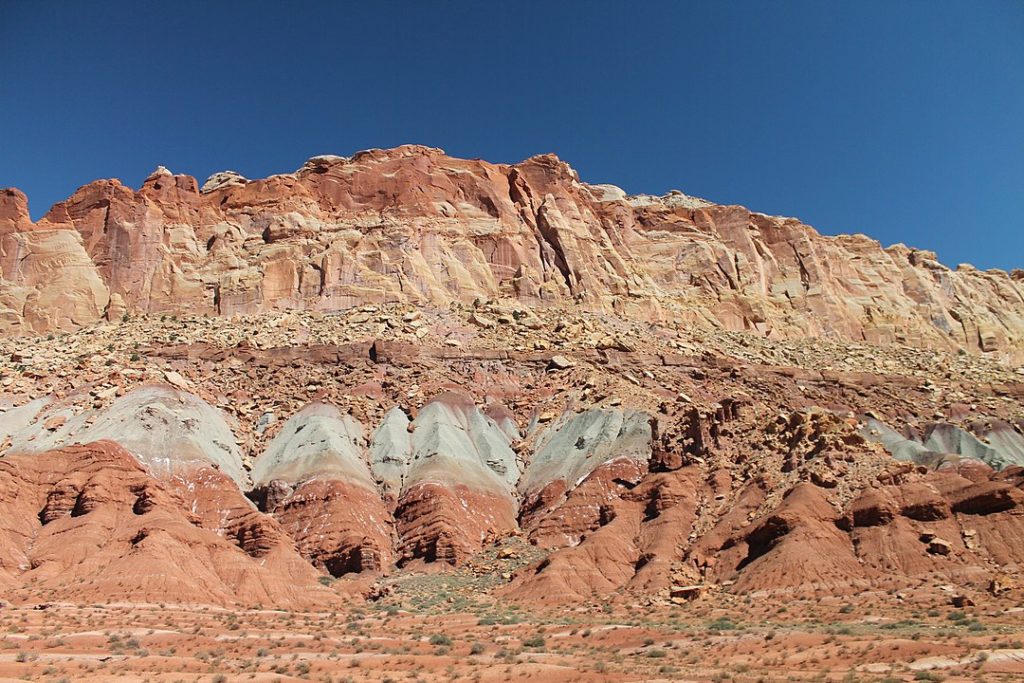
There must be some point in the geologic record where the Flood begins. We call this the pre-Flood/Flood boundary. Likewise, there must also be a higher point in the geologic record where the Flood ends. This is the Flood/post-Flood boundary. It is common for creationists to identify a single point in the geologic record where the Flood begins or ends and apply it worldwide. This may be appropriate for the pre-Flood/Flood boundary. The Bible records that the Flood had sudden beginning. All the fountains of the great deep burst forth and a torrential downpour occurred over the whole earth. Finding the Flood/post-Flood boundary is considerably more difficult. The Flood came to a slow and gradual end, with the floodwaters taking many months to recede before Noah could leave the Ark.
Short of assigning absolute dates to the rocks, we shouldn’t necessarily assume that one unit of rock layers in Wyoming (e.g. the lower Eocene) was laid down at the same time as rock layers assigned to that same unit in Israel. In a sense, we should not be asking where in the geologic record the Flood ended. What we are really looking for are the figurative footprints of Noah after he left the Ark. Where in the geologic record is the land surface upon which Noah would have been walking?
Pick a Boundary, Any Boundary!
Many young-earth geologists caution against trying to find a hard and fast, universal post-Flood boundary. For example, geologist Dr. John Whitmore thinks that the Flood/post-Flood boundary in Wyoming coincides with the divide between the Cretaceous and Paleogene. But in Israel, he thinks that the post-Flood boundary lies within the Paleogene. In other regions of the world, it might lie lower in the geologic record.
Nevertheless, there are four main ranges within the global geologic column where young-earth geologists will generally place the boundary:
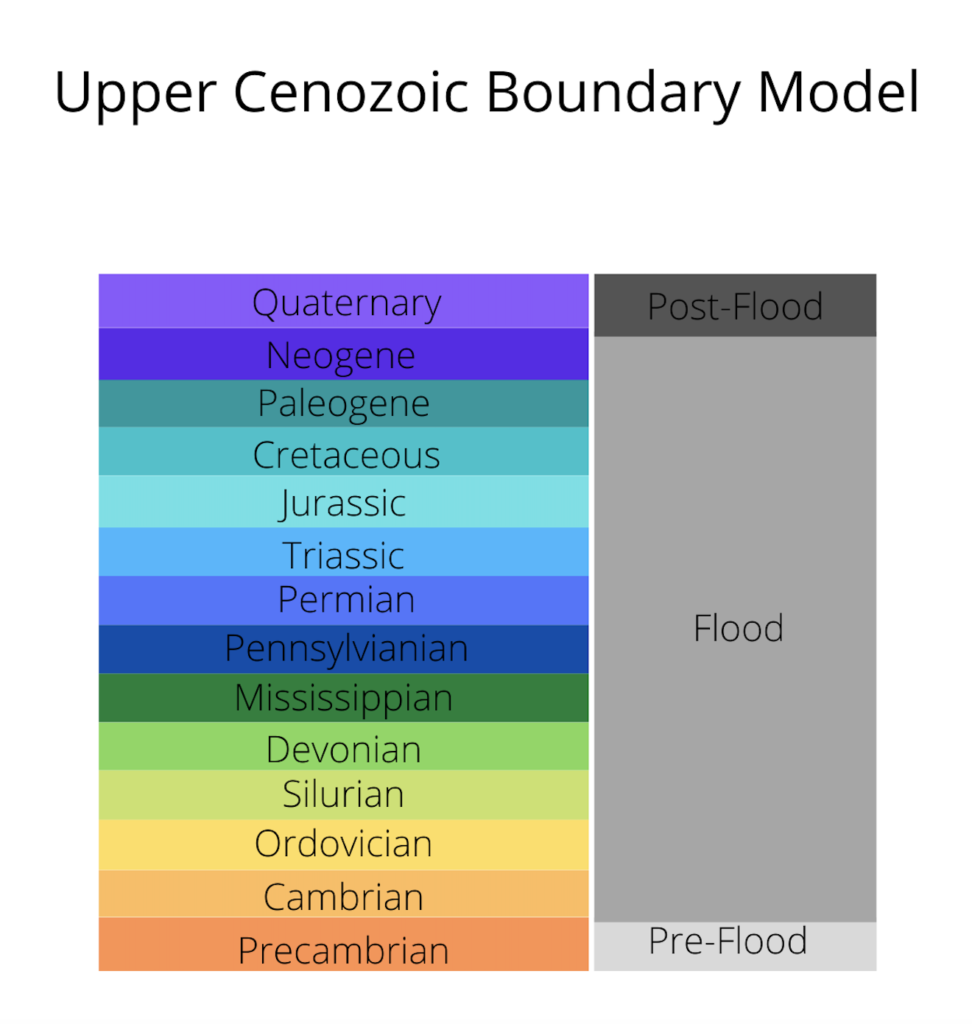
Most of the geologic record was formed during Noah’s Flood.
The Flood was responsible for most of the Cambrian through Cretaceous layers, and perhaps some Paleogene deposits.
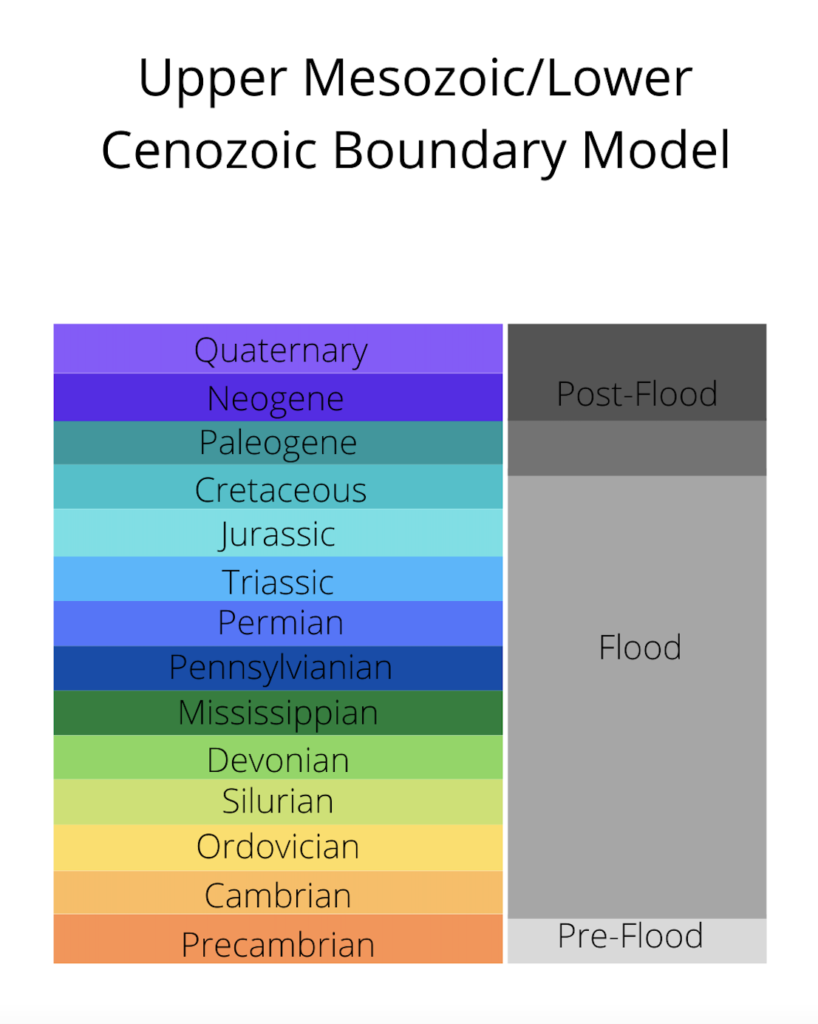
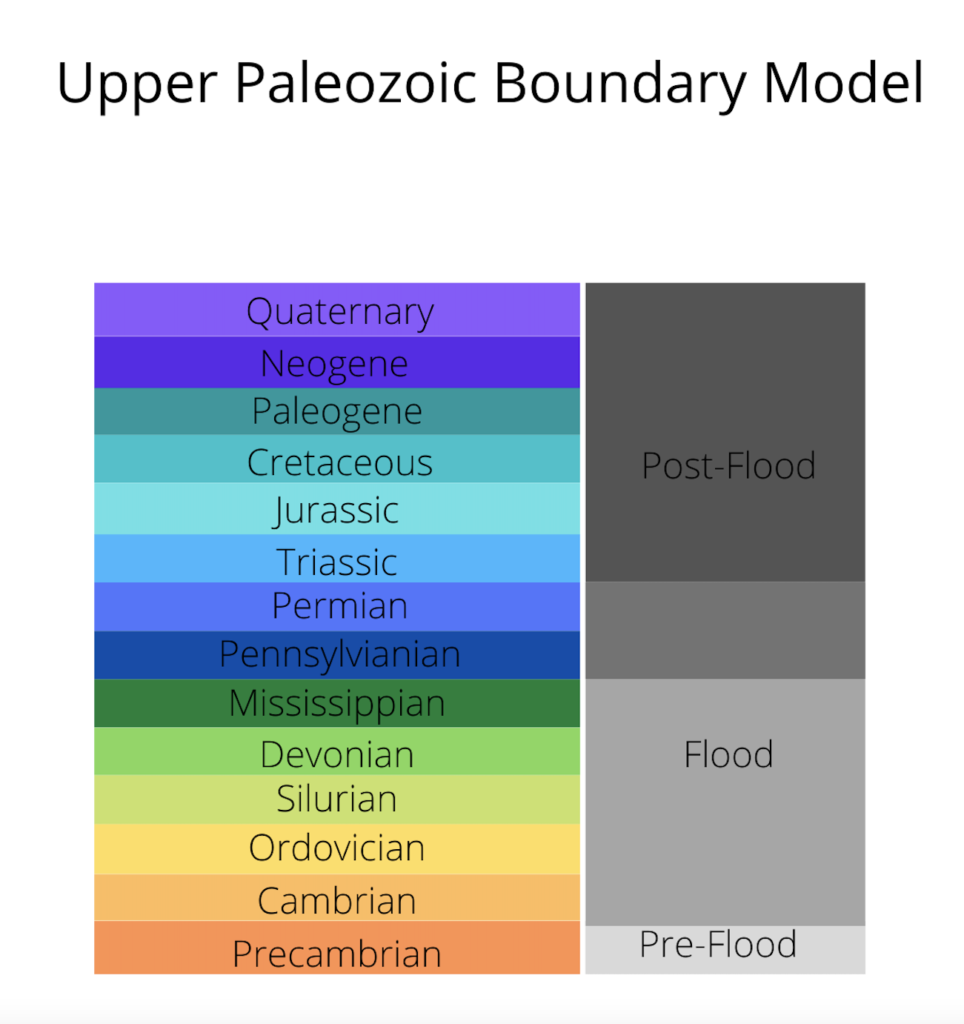
The Flood begins with the Cambrian and ends somewhere between the Mississippian and the lower Triassic layers.
The vast majority of the geologic record reflects post-Flood events.
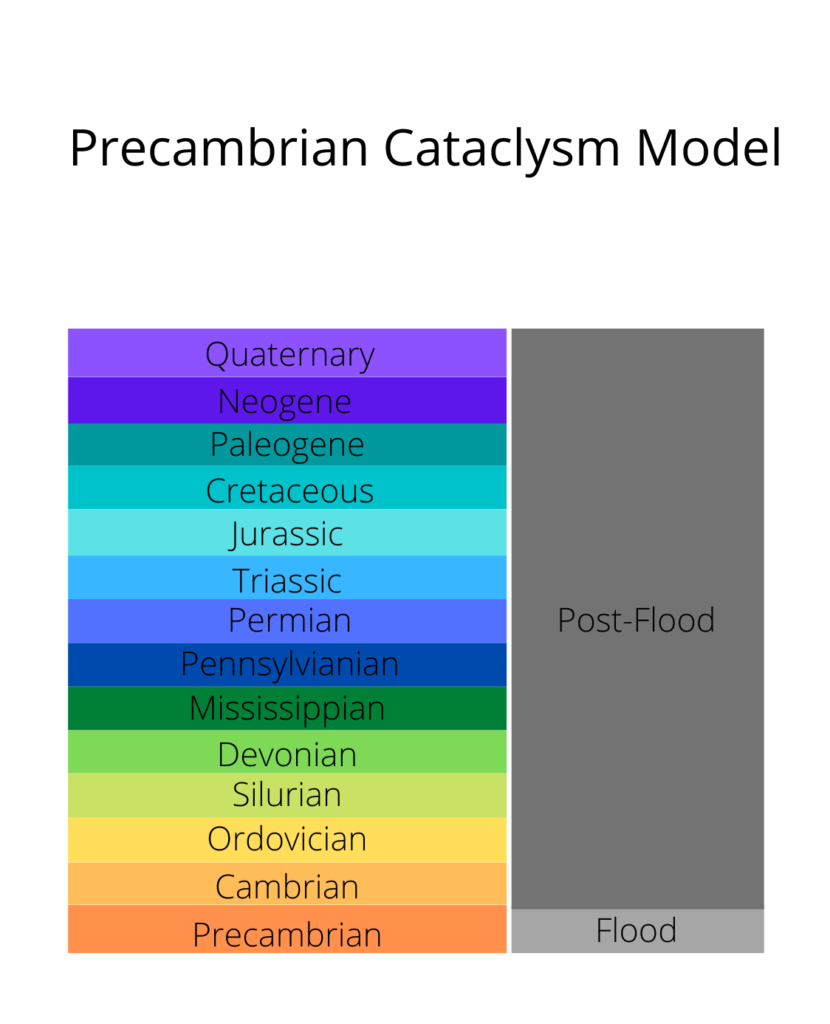
Geologic Column In Perspective
The geologic column, as portrayed in textbooks, is sort of like a field guide you might use while visiting a national park. The field guide contains a diverse array of species that should exist in the national park. However, you are unlikely to see all of these species while you are there. Likewise, the geologic column is our field guide to the earth’s rock record. It tells us which rock layers should appear above or below other rock layers. But there are no places on the earth where you will see the geologic column as diagrammed in textbooks.
It may be more helpful to apply this search for the Flood layers to a real-world location where much of it can be found. One such location is the Grand Staircase of Arizona and Utah. Here, the layers of which it is composed have been exposed primarily in the Grand Canyon, Zion Canyon, and Bryce Canyon.
Please check out The Hitchhiker’s Guide to the Grand Staircase in the appendix below, where we will look at the Grand Staircase in Arizona and Utah. The layers of which it is composed lie exposed primarily in three national parks in the area. Click here for a generalized overview.
Conclusion
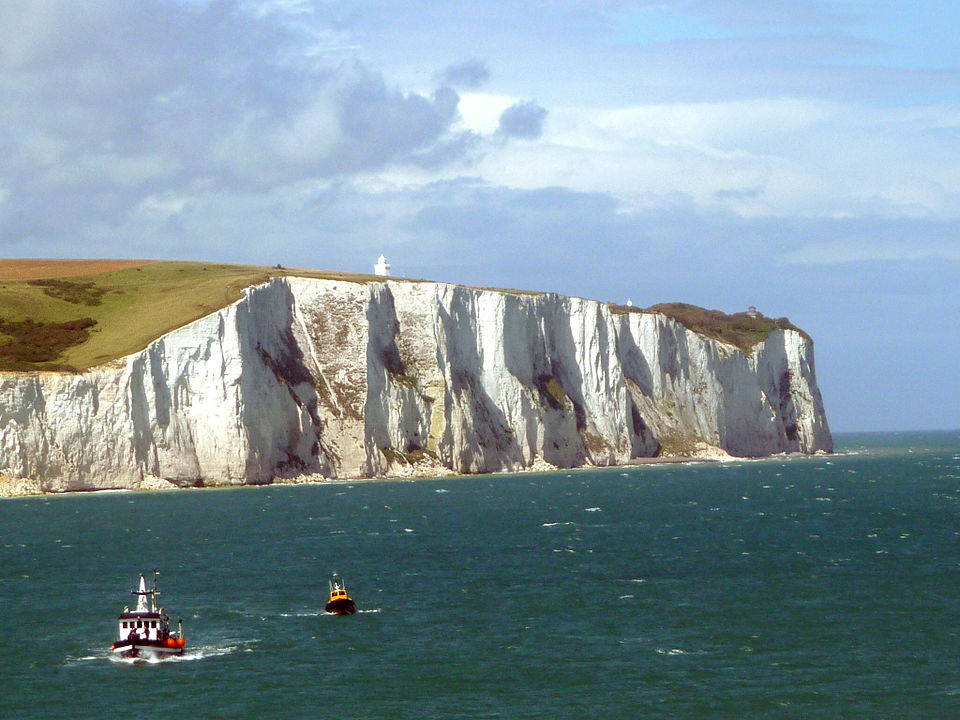
As you can see, the study of the geologic record as it relates to Noah’s Flood is a work in progress. Creationists are united in their quest to correlate the geologic record with the history recorded in the Bible. However, they have come up with differing ideas about how the Flood impacted earth history. Each of the four main views presented above hold merit. It is good for creationists to explore various theories in order to make sure that no stone goes unturned in their quest to understand the truth of the matter. Further study and research will likely help creationists to come to a consensus on the topic.
It is our hope that you can use this article as a guide on your own quest to unravel the enthralling history of our planet as it relates to the historical record given in God’s Word.




